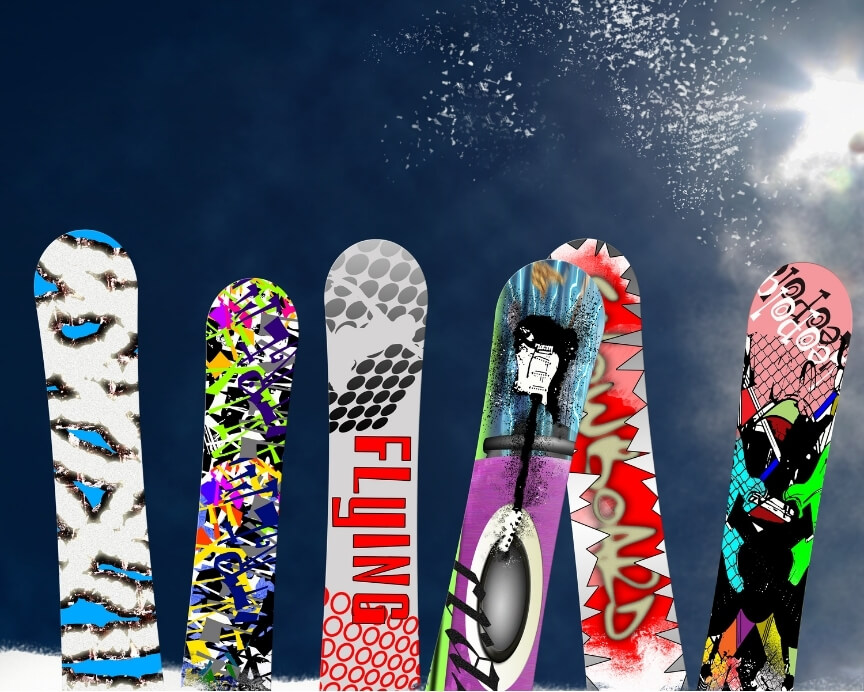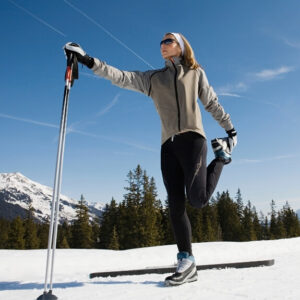Blog, Physiotherapy
Common Snow Sports Injuries – How to Stay Safe on the Slopes

There’s nothing quite like the thrill of carving through fresh powder of the untouched back country or gliding down a freshly groomed slope.
However, as with any sport, skiing and snowboarding come with their fair share of risks. Whether you’re a beginner or a seasoned pro, injuries can happen.
Understanding the most common snow sports injuries and how to prevent them can help you enjoy the mountains safely and avoid time off the slopes.
Common Snow Sports Injuries and How to Prevent Them
-
Knee Injuries
Knee injuries are prevalent among skiers, often resulting from the rotational forces experienced during abrupt turns or falls. Such movements can cause damage to ligaments like the ACL and MCL. Additionally, improperly adjusted ski bindings that fail to release during a fall may heighten the risk of these injuries.
Prevention Tips:
- Strengthen your quadriceps and hamstrings to support your knees.
- Ensure your ski bindings are properly adjusted to your weight and skill level.
- Practice proper technique, keeping your knees flexed and avoiding sudden twisting motions when the skis are heavily weighted.
-
Wrist and Hand Fractures
Snowboarders often sustain wrist injuries because they instinctively use their hands to cushion falls, leading to sprains or fractures, including those of the scaphoid bone.
Prevention Tips:
- If you know you have vulnerable wrists, wearing wrist guards designed for snowboarding may help.
- Learn how to fall properly by rolling onto your forearms instead of extending your hands. Practicing falling in a controlled way can assist with this so it becomes instinctive when you have less control over your fall.
- Strengthen your wrist and forearm muscles for better impact absorption. This can also help build up bone density.
-
Shoulder Dislocations and Clavicle Fractures
In snowboarding, high-velocity falls can lead to shoulder dislocations or clavicle fractures, especially when landing on an outstretched arm or experiencing direct shoulder impact.
Prevention Tips:
- Strengthen your shoulder muscles to improve stability.
- Practice controlled falls to avoid direct impact on the shoulder.
- Consider where you’re riding and make sure you’re riding within your skill/comfort level.
-
Head Injuries and Concussions
Mishaps such as collisions, falls, or unsuccessful jumps can result in concussions or other traumatic brain injuries. Wearing a properly fitted helmet can mitigate the severity of these injuries but cannot entirely eliminate the risk.
Prevention Tips:
- Always wear a properly fitted helmet certified for skiing or snowboarding.
- Be aware of your surroundings and follow slope etiquette, if the other person is downhill of you, they have right of way.
- Avoid high-risk jumps and tricks that are beyond your skill level.
- Be aware of your own skill level and manage your speed accordingly. You don’t want to end someone else’s holiday by wiping them out either.
-
Ankle and Foot Injuries
The stiff design of snowboard boots makes snowboarders susceptible to ankle injuries, such as sprains and fractures. A notable example is the “snowboarder’s fracture,” impacting the lateral process (outside portion) of the talus bone.
Prevention Tips:
- Ensure your boots fit properly and provide adequate support.
- Strengthen your lower leg muscles to improve stability.
- Warm up before hitting the slopes to enhance flexibility and reduce stiffness.
-
Spinal Injuries
Engaging in high-impact activities, like jumps or navigating challenging terrains without adequate experience, can lead to serious spinal injuries, including fractures or disc injuries.
Prevention Tips:
- Know your limits and avoid terrain beyond your skill level.
- Engage in core strengthening exercises to support your spine.
- Wear appropriate protective gear, such as butt pads and helmets, if engaging in high-impact tricks.
Tips for Injury Prevention and Safer Riding
Warm-Up and Stretch – Engaging in light exercises before skiing or snowboarding enhances muscle flexibility and reduces stiffness, lowering injury risk.
Maintain Control – Avoiding excessive speeds and risky manoeuvres helps prevent falls and collisions.
Equip Properly – Using well-maintained, correctly fitting equipment plays a crucial role in preventing injuries.
Seek Professional Instruction – Learning proper techniques from qualified instructors can significantly reduce injury chances (and accelerate your progress with your skiing or snowboarding skills).
Rest Appropriately – Recognising signs of fatigue and taking necessary breaks can help prevent accidents caused by tiredness.
Hydrate and Nourish – Maintaining good nutrition and hydration supports endurance and muscle function, aiding in injury prevention.
Snow sports come with inherent risks, but by understanding common injuries and implementing preventative measures, you can reduce your chances of getting hurt.
Whether you’re a seasoned pro or a beginner, prioritising safety will ensure that you enjoy more time on the slopes and less time in recovery.
Stay safe, have fun, and make the most of the winter season!
 |
Written By:
Mattias McAndrew (Head Physiotherapist) Bachelor of Physiotherapy (Hons) |
References
Karlsson, J., & Werner, S. (2021). Sports injuries: Prevention, diagnosis, treatment, and rehabilitation. Springer.
Maffulli, N., Longo, U. G., Gougoulias, N., Loppini, M., & Denaro, V. (2010). Long-term health outcomes of youth sports injuries. British Journal of Sports Medicine, 44(1), 21–25. https://doi.org/10.1136/bjsm.2009.069526
Shealy, J. E., Ettlinger, C. F., & Johnson, R. J. (2005). How fast do winter sports participants travel on alpine slopes? Journal of ASTM International, 2(7), 1–8. https://doi.org/10.1520/JAI12092
Sulheim, S., Holme, I., Ekeland, A., & Bahr, R. (2006). Helmet use and risk of head injuries in alpine skiers and snowboarders. JAMA, 295(8), 919–924. https://doi.org/10.1001/jama.295.8.919


